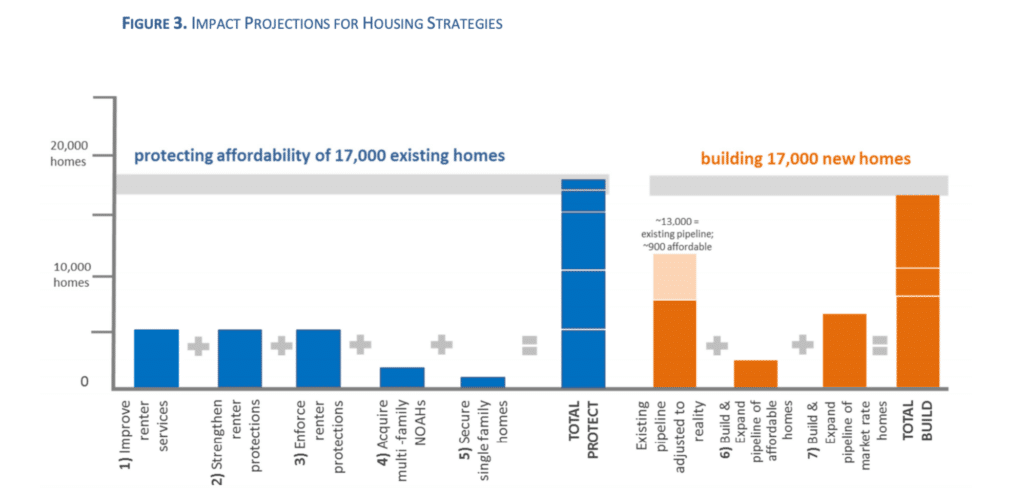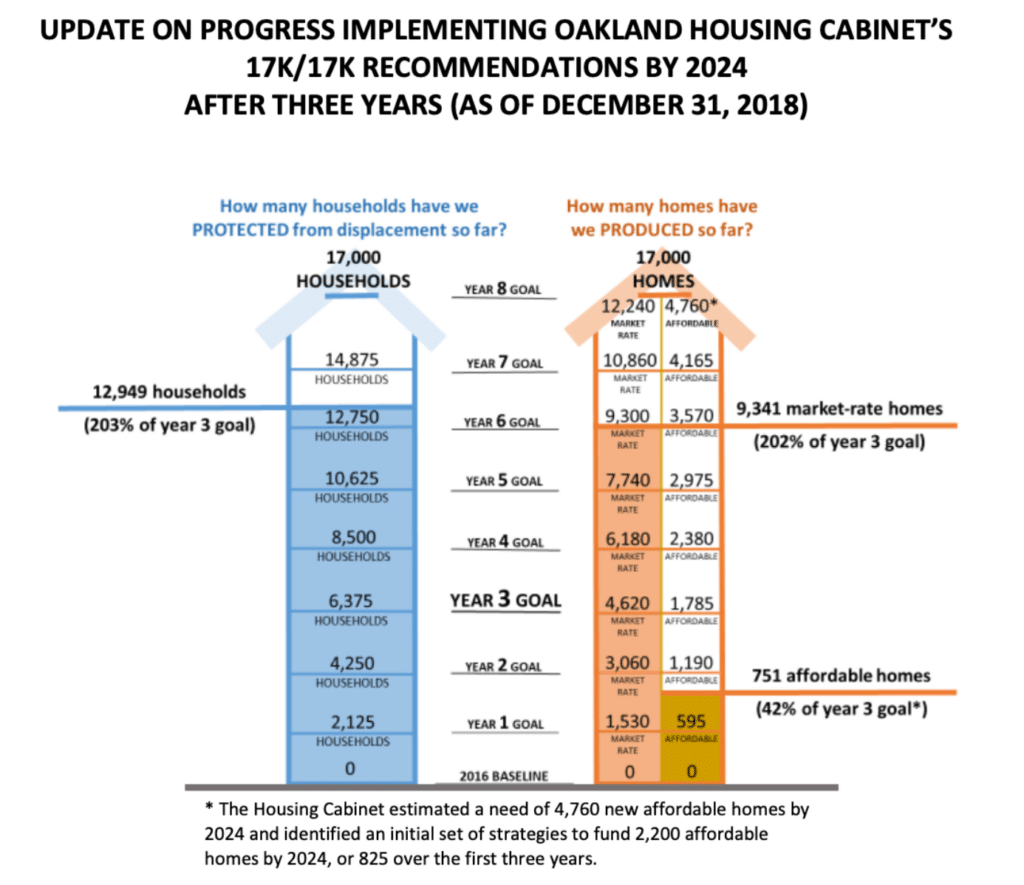Oakland
- Published:

Locality: Oakland, California
City Population: 425, 097 (2019)
Metro Population: 7.8 million (2018)
Plan Title: Oakland at Home: Recommendations for Implementing A Roadmap Toward Equity
Date of Plan: March 2016
Date of Case Study: June 2021
Substantive highlights
This profile features the policy framework and implementation plans developed and adopted in the City of Oakland to address its affordable housing crisis. The San Francisco Bay area has experienced extraordinary economic growth throughout the past two decades and Oakland has become a top destination for tech entrepreneurs. While the economy has prospered and created thousands of new jobs in the area, housing costs have increased more quickly than income levels, and the region’s housing production has not kept pace with the growing workforce. This mismatch in supply and demand has resulted in increasingly insufficient affordable housing options for existing and new lower-income residents in cities throughout the Bay Area—including Oakland.
Adopted by the Oakland City Council in September 2015, “A Roadmap Toward Equity: Housing Solutions for Oakland, California” (the “Roadmap”) established a policy framework to address the city’s most pressing housing needs, and its corresponding implementation plan, “Oakland at Home: Recommendations for Implementing A Roadmap Toward Equity From the Oakland Housing Cabinet” (“Oakland at Home”), was published in March 2016.
Prioritizing the preservation of affordable homes, the recommendations and strategies highlighted in the Roadmap and Oakland at Home reinforce the city’s belief that fixing housing is a shared responsibility among all of the city’s stakeholders across both public and private sectors — including for-profit and non-profit developers and residents.
The strategy’s implementation recommendations are broken down into three buckets of work, representing each of the city’s main housing goals. Each bucket offers a variety of recommended strategies and policy tools to meet the city’s goals (see Policy Tools below for more information):
- Protect Affordability for Oakland Residents
- Improve renters’ services
- Strengthen renters’ protections
- Strengthen enforcement of renters’ protections
- Acquire naturally occurring affordable housing
- Secure single-family homes in financial distress
- Create New Homes
- Build the existing pipeline of affordable homes and add new ones
- Built the existing pipeline of market-rate homes and add new ones
- Ensure Steady Progress for Oaklanders
- Set up an internal working group to track achievements and coordinate policies
- Ensure Oaklanders have preference in new affordable housing
- Raise funds from philanthropy and others to support the work
Process
Prior research on the housing needs in Oakland prompted the Oakland City Council and the city’s Department of Housing & Community Development to commission an updated analysis of the city’s housing challenges and recommendations on comprehensive policy solutions.
In partnership with PolicyLink and the Urban Strategies Council, the City of Oakland Department of Housing & Community Development’s Strategic Initiatives Unit produced “A Roadmap Toward Equity: Housing Solutions for Oakland, California.” The report describes Oakland’s housing crisis and contains information on the changing tenure and demographics of the city’s neighborhoods, as well as how the city’s affordability challenges impact the locality’s efforts to develop equitable and inclusive communities. The Roadmap revealed that “15 neighborhoods with different median housing costs show that the majority of both renter and homeowner residents would not be able to afford a median-priced home in their neighborhood.” Similarly, their research found that about 1,000 Oakland homeowners in foreclosure were long-time homeowners, and often elderly, disabled, or families with school-aged children. The report then recommends a number of strategies that can be implemented immediately to address Oakland’s unique housing challenges.
Adopted by the City Council in September 2015 as a framework for addressing the housing crisis, the Roadmap identified three priority issue areas: 1) Preventing the displacement of current residents, 2) Producing new affordable housing, including housing for those at 15% percent area median income (AMI) or below, and 3) Improving habitability conditions. Each priority was supported by a number of policies and programs to advance the goal, to provide the housing infrastructure needed to enable long-time residents to remain and benefit from the area’s success, and to protect and serve the area’s most vulnerable residents, all while honoring the city’s historic diversity.
The Roadmap’s policy and program guidance were developed with input from various stakeholders, including families facing displacement, public administrators, housing advocates, tenant groups, homeowners, developers, elected officials, and business associations. PolicyLink also reviewed best practices nationwide to better understand scalable solutions.
While the Roadmap created a framework to understand the city’s housing crisis and suggestions for how to remedy it, it did not spell out policy or budgetary constraints or outline an action plan. To fill this gap, Mayor Libby Schaaf established a Housing Cabinet in 2015 to create a practical implementation plan for the Roadmap. The Mayor’s Housing Cabinet consisted of Councilmembers, City of Oakland staff, finance experts, mission-oriented developers, market-rate developers, advocates, and legal experts.
Over an eight-month period, the Cabinet:
- Conducted shortfall analysis, a disproportionate impact analysis, and a severe cost burden analysis to create numeric program goals, including how many homes needed to be protected and built over the next eight years.
- Established a set of shared values and criteria for feasibility and impact.
- Created nine working groups and reached out to stakeholder groups.
- Outlined detailed next steps needed to advance key ideas.
- Confronted difficult trade-offs to prioritize actions.
- Recommended actions to protect and build housing, and considered action steps and strategies with strategic sequencing and realistic timelines.
- Identified lead departments and organizations to help advance the strategies and to increase resources.
The Housing Cabinet’s final report, Oakland at Home, was published in March 2016 and outlines implementation goals and strategies over an eight-year period. The Housing Cabinet also obtained city departmental and stakeholder commitments to effectively implement the strategy, ensuring that correct teams were looped into the implementation process.
Metrics, targets, and implementation
Oakland at Home’s goals fall into two main categories, which the city hopes to accomplish by the year 2024.
- Preservation of existing units: Protect housing for extremely low-income, very low-income, and low-income households, as well as households living in rent-restricted properties at risk of loss of affordability in the next 10 years.
- Protect 2,125 households per year and 17,000 total.
- Production of new units: Build both market-rate and affordable housing.
- Build 1,800-2,500 households per year, and 14,400-20,000 households total.

Implementation status
In July 2017 the City of Oakland published a report of the first year’s progress in implementing the Housing Cabinet’s recommendations, followed by another updated report in 2019. By the publication of the report in March 2019, over 90% of the Cabinet’s recommended actions were underway or already complete. According to the progress report, nearly 13,000 Oakland residents were enjoying new tenant protections and services, and more than 10,000 new homes were produced. However, the vast majority of these homes were market-rate homes (see image below).
Indicators also suggested that:
- Oakland rents appear to be stabilizing, based on the small increase in citywide rents in 2018.
- Evictions in Oakland are declining.
- The percentage of rent-burdened Oakland residents is declining, particularly for Latino renters.
- The locality is producing more affordable housing, but even with the increase in production, the City still met less than half of Oakland’s need for protected affordable units over the three years since the goal was created.

Coverage of four policy pillars
| Coverage of Four Policy Pillars | Not Covered | Moderate Focus | Substantial Focus |
| Create and preserve dedicated affordable housing units | – | – | ✓ |
| Promote affordability by reducing barriers to new supply | – | – | ✓ |
| Help households access private-market homes | – | ✓ | – |
| Protect against displacement and poor housing conditions | – | – | ✓ |
Participating agencies
| Participating Agencies | No Role | Supporting Role | Leading Role |
| Office of the Mayor | – | – | ✓ |
| Office of the City/County Manager | – | – | ✓ |
| Housing Department | – | – | ✓ |
| Planning Department | – | – | ✓ |
| Development Agency | – | – | ✓ |
| Permitting/Inspections Department | – | – | ✓ |
| Finance/Tax Department | – | ✓ | – |
| Public Housing Authority | – | – | ✓ |
Policy tools
Improve Renters’ Services
- Complete an audit and redesign of their Rent Adjustment Program to serve more clients well.
- Modernize the housing services system.
- Expand contracts with local groups to extend the City’s outreach and assist with more tenant issues.
- Create a larger, more sustainable funding source and align the staffing structure to meet the needs of programs providing services.
- Improve data collection.
- Develop an emergency bridge fund to help monitor rent increases for the most vulnerable households.
Strengthen Renters’ Protections
- Improve the Just Cause for Eviction Ordinance.
- Revise the locality’s Condo Conversion Ordinance.
- Propose amendments to strengthen the area’s Tenant Protection Ordinance and its’ administrative and enforcement mechanisms.
- Revise local ordinance to impose higher payouts to tenants.
- Revise code enforcement relocation program.
- Explore a new Neighborhood Stabilization Ordinance to replace an existing Rent Adjustment Ordinance.
Strengthen the Enforcement of Renters’ Protections
- Increase fees for the Rent Adjustment Program.
- Add further legal safeguards for vulnerable community members threatened by growing displacement forces and inadequate housing security.
- Implement the sale of public lands with proceeds designated for increased enforcement of renter protections.
- Expand and enhance the existing Safe Housing Inspection Program into a city-wide proactive rental inspection policy.
Acquire Naturally Occurring Affordable Housing
- Establish an independent Workforce Housing Preservation Taskforce.
- Pursue a City Infrastructure Bond that includes NOAH Rehabilitation funds.
- Work with the Metropolitan Transportation Commission to explore and develop a regional NOAH Fund.
- Set up a Transfer Tax Rebate for the renovation of NOAHs by nonprofit organizations
- Increase capacity for small site acquisition and management.
- Develop best management practices and build the capacity of local organizations to acquire, rehab, and manage small and medium scaled scatter site homes.
Secure Single Family Homes in Financial Distress
- Secure single-family homes in financial distress.
- Establish a Scattered Site Homeownership Land Trust.
Build and Expand Pipeline of Affordable Homes
- Adopt a financially feasible affordable housing impact fee on new private market-rate residential development that requires either fees or actual affordable units within the project.
- Create a Public Land Policy.
- Dispose of city properties and include an affordable housing benefit.
Build and Expand Pipeline of Market Rate Homes
- Support the creation of units that are efficient to construct.
- Ensure that the permitting process provides certainty and makes the best use of city resources and public input.
- Proceed with Exclusive Negotiating Agreements, as well as Disposition and Development Agreements leader to public/private development of Redevelopment Successor Agency properties.
Ensure Steady Progress for Oaklanders
- Set up an internal working group to refine and implement strategies and policies.
- Staff a small Advisory Committee to spearhead implementation.
- Set up and manage a website for the community to track progress.
- Receive clarification on appropriate and legal language to build into project approvals where City funds are used that would ensure that Oaklanders have preference in new affordable housing developments.
- Craft language and work directly with San Francisco and other cities to make more changes at the state level to make it easier to do.
- Raise funds from philanthropy, the business community, and individuals to support some of the activity or capital needs.
Income groups targeted
| Income Groups Targeted | Little/No Focus | Moderate Focus | Substantial Focus |
| 0-30% AMI | – | ✓ | – |
| 30-60% AMI | – | ✓ | – |
| 60-80% AMI | – | ✓ | – |
| 80-120% AMI | – | ✓ | – |
| Market Rate | – | ✓ | – |
Key policy objectives or issues addressed
- ✓ Improve renters’ services
- ✓ Strengthen renters’ protections
- ✓ Strengthen enforcement of renters’ protections
- ✓ Acquire naturally occurring affordable housing
- ✓ Secure single family homes in financial distress
- ✓ Build the existing pipeline of affordable homes and add new ones
- ✓ Build the existing pipeline of market rate homes and add new ones
Which linkages are addressed
- ✓ Health
- ✓ Transportation
Which local funding sources are proposed?
Existing funding sources, proposed for continuation and/or increase:
- ✓ General city funds
- ✓ Program fees
- ✓ Sustainable Communities (“Cap and Trade”)
Proposed new sources:
- ✓ Transfer tax rebates
- ✓ Enhanced infrastructure finance district
- ✓ County and city bonds
- ✓ Scattered site homeownership trust
- ✓ Sale of public land
- ✓ Work with Metropolitan Transportation Commission to explore and develop a regional NOAH fund
Additional resources
“City Council approves plan to prevent displacement of residents, increase affordable housing,” Oakland North
Oakland At Home Update: A Progress Report on Implementing A Roadmap Toward Equity From the Oakland Housing Cabinet
“Oakland, CA Adopts Roadmap to Promote Housing Equity,” Shelterforce
“New Report Shows City of Oakland’s Strong Progress on Housing Goals,” City of Oakland
“Oakland Achieves Success with Strategy to Address Housing Affordability and Displacement,” National League of Cities
Standard content paragraph